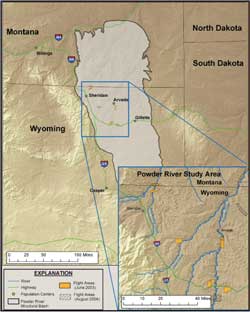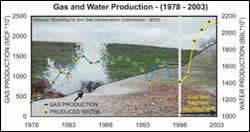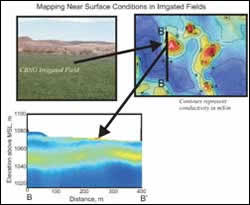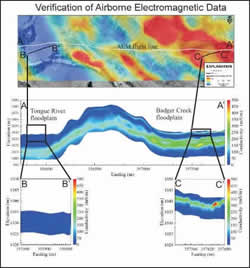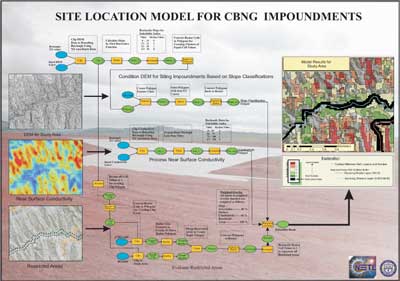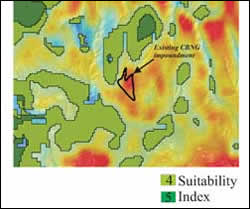ArcUser Online
ArcGIS ModelBuilder was used to create a GIS-based decision support model that incorporated digital elevation data and electromagnetic geophysical results gathered by helicopter to screen potential sites for water disposal impoundments produced from coal bed natural gas. CBNG production typically requires removal of large volumes of water from coal beds. Wells may initially produce 12 to 25 gallons of water per minute (gpm) but will generally produce approximately four gpm over an average operating life of 7 to 10 years. Over time, the rate of water discharge gradually decreases as does the amount of recovered gas. Over the next 15 years, the Bureau of Land Management has estimated that 1.4 to 5 trillion gallons of water in Wyoming and as much as three trillion gallons of water in Montana will be removed due to CBNG production. Extracted water is moderately saline and contains elevated levels of sodium relative to other cations (i.e., ions having a positive charge). If the water quality is suitable, extracted water is often reused for beneficial purposes such as irrigation or stock watering. Unused produced water is disposed of through direct surface discharge, infiltration impoundments, and evaporation ponds. The potential environmental impacts associated with produced water disposal encompass water resource depletion, water quality degradation in surface and groundwater systems, and altered agricultural lands. Powder River Basin CBNG ReservesEncompassing more than 22,000 square miles in Montana and Wyoming, the Powder River Basin has experienced significant CBNG development since 1993. Estimates of CBNG reserves vary depending on the calculation method used. However, conservative reserve estimates of the total gas in place for the Powder River Basin are up to 90 trillion cubic feet (TCF) in Montana and 38 TCF in Wyoming.
In Wyoming, development of CBNG has increased rapidly over the past decade. Since 1993, the annual production of CBNG in the Powder River Basin has doubled every year through 2001 from a little more than 1 billion cubic feet (BCF) in 1993 to 256 BCF in 2001. In early 2004, close to 1 BCF of CBNG was produced each day. By the beginning of 2004, 1.2 TCF of natural gas had been recovered from the Powder River Basin.
In the 1990s, much of the production of CBNG in the Powder River Basin came from the Wyodak-Anderson coal bed near Gillette, Wyoming. More recently, development has occurred west of Gillette in the Big George coal bed and northwest of Gillette in multiple coal seams. Study DataIn 2003 and 2004, the National Energy Technology Laboratory of the United States Department of Energy, in collaboration with the United States Geological Survey, Wyoming Department of Environmental Quality, and the Department of Geology and Planetary Science at the University of Pittsburgh, completed a Frequency Domain Airborne Electromagnetic (AEM) survey in the Powder River Basin as part of a hydrologic study of coal bed natural gas production. The intent of this survey was to evaluate AEM for large-scale mapping of vadose (i.e., water located in the aeration zone of the earth's crust above the groundwater level) zone electrical conductivity and water quality variation within shallow aquifers to evaluate the effects of produced water disposal. The nine study sites covered approximately 210 square kilometers (km2) of upland and floodplain areas within the basin. Interpretation of the apparent conductivity maps and inverted conductivity depth sections revealed lithologic heterogeneities and water quality variations that were ultimately used to infer hydrologic processes. GIS-based models were used to couple seemingly unrelated spatial datasets in a manner that may provide industry and environmental agencies with an effective tool for produced water management. The near-surface conductivity map and depth section of a field irrigated with produced water (shown in Figure 1) were generated by geophysical inversion of the AEM data. There is a conductive anomaly that is interpreted as an elevated pore water salinity and/or salt accumulation that may have resulted from the moderately saline produced water used to irrigate the field. The anomaly at location A in Figure 1 has a mean apparent conductivity value of 143 milli-Siemens per meter (mS/m) [a measurement of conductivity], which is ~2 times above the background conductivity values of 62 mS/m for the adjacent areas. AEM data was also useful to elucidate water quality variability of Powder River Basin alluvial aquifers. Figure 2 depicts a near-surface AEM-derived conductivity image for an area south of the Tongue River and Badger Creek confluence. Included in the figure is a conductivity depth section derived from AEM data and an analogous ground-based system (e.g., a GEM 2 handheld digital and programmable broadband electromagnetic sensor manufactured by Geophex). There is a shallow alluvial aquifer associated with each stream. However, the Tongue River aquifer contains water with lower total dissolved solids (TDS) concentration than the Badger Creek system as observed on the map and depth sections. Lower electrical conductivity corresponds to TDS levels. Identifying Potential SitesArcGIS was used in all stages of analysis of the AEM data that was used to identify potential problem areas for new impoundments. All AEM apparent conductivities were imported into ArcGIS personal geodatabases. In addition, ERMAPPER format raster (.ers) files were used for some geophysical datasets. AEM data was then interpreted to determine near-surface conductivity. Other raster datasets used in the analysis included topography, remote sensing images, and restricted area polygon feature class-based data. ArcGIS ModelBuilder was perfectly suited to the task of building a decision support model for evaluating the near-surface conditions that were used in siting CBNG water storage impoundments. Figure 2 shows this model, which combines digital elevation data, near-surface apparent conductivity (which is a proxy for naturally occurring salts in the subsurface), and restricted areas.
Using ArcGIS, all geophysical datasets could quickly and efficiently be incorporated into a regional framework and used to determine a suitability index for potential impoundment sites. Figure 3 shows results from a study area in which an existing CBNG impoundment was built over highly conductive surface materials to store water. A perched aquifer formed in the underlying sediments (~5 to 9 meters thick), which had TDS levels up to two orders of magnitude higher than the input CBNG water.
Locations surrounding the impoundment may have been more suitable, based on the results of the GIS model. However, on-site field studies would be necessary to properly evaluate site conditions for any water management plans. Future plans are to add more complexity to the model through incorporating more information used in the decision process for produced water management. For more information, see www.netl.doe.gov and harbert.geology.pitt.edu or contact
650 Office: 84-101 Mail Stop: 84-108 Tel.: 412-386-5767 E-mail: james.sams@netl.doe.gov AcknowledgmentsThe authors thank the Bureau of Land Management, Wyoming Department of Environmental Quality, Wyoming Oil and Gas Conservation Commission, and the gas producers and landowners in the Powder River study areas who provided access to their property along with data and information. ReferencesArthur, D., B. Langhus, and V. Rawn-Schatzinger, 2003. "Coalbed Natural Gas Resources and Produced Water Management," GasTIPS Summer 2003. Hart Publications, Houston, Texas. Brink, E., J. Wheaton, and C. Frost, 2004. "Tracking CBM Infiltration Pond Impacts Upon Groundwater Using Strontium Isotopes," Geological Society of America Abstracts with Programs, Vol. 36, No. 5, p. 327. Bryner, G., 2002. "Coal bed Methane Development in the Intermountain West: Primer," Proceedings of Coal bed Methane Development in the Intermountain West, Natural Resources Law Center, University of Colorado School of Law, Boulder, Colorado, 1�50. Cook L., 2002. "The Geology and Production Characteristics of the Powder River and Other CBM Basins in Wyoming," Proceedings of Coal bed Methane Development in the Intermountain West, Natural Resources Law Center, University of Colorado School of Law, Boulder, Colorado, 245�251. Darin, T. F., 2002. "Waste or Wasted? Rethinking the Regulation of Coalbed Methane Byproduct Water in the Rocky Mountains: A Comparative Study of Approaches to CBM Produced Water Quantity Legal Issues in Utah, New Mexico, Colorado, Montana, and Wyoming." Proceedings of Coal bed Methane Development in the Intermountain West, Natural Resources Law Center, University of Colorado School of Law, Boulder, Colorado, 187�216. De Bruin, R. H., R. M. Lyman, R. W. Jones, and L. W. Cook, 2004. "Coalbed Methane in Wyoming," State of Wyoming Geological Survey Information Pamphlet 7 (second revision), Laramie, Wyoming, 23 p. Likwartz D., 2002. "A Review of CBM Development in the Powder River and Other Wyoming Basins," Proceedings of Coalbed Methane Development in the Intermountain West, Natural Resources Law Center, University of Colorado School of Law, Boulder, Colorado, 251�256. Nogaret, L., 2002. "The Hydrology of Coal bed Methane Reservoirs and the Interplay of Gas, Water, and Coal in CBM Production," Proceedings of Coal bed Methane Development in the Intermountain West, Natural Resources Law Center, University of Colorado, Boulder, Colorado, 133�138. Rice, C. A., M. S. Ellis, J. H. Bullock, Jr., 2000. "Water Co-produced with Coalbed Methane in the Powder River Basin, Wyoming: The Preliminary Compositional Data." USGS Open-File Report 00-372, 18 p. Stearns, M., J. A. Tindall, G. Cronin, M. J. Friedel, and E. Bergquist, 2005, "Effects of Coal-Bed Methane Discharge Waters on the Vegetation and Soil Ecosystem in the Powder River Basin, Wyoming." Water, Air, and Soil Pollution, v. 168, 33�57. United States Department of the Interior, Bureau of Land Management, 2002. Draft Environmental Impact Statement and Draft Planning Amendment for the Powder River Basin Oil and Gas Project, Vol. 1, 4�12, 4�23. United States Geological Survey, 2000. "Water Produced in Coal-Bed Methane," USGS Fact Sheet 156-00, 2 p. About the AuthorsJames Sams received a bachelor's degree in chemistry from West Liberty State College and bachelor's and master's degrees in earth and environmental science from the Pennsylvania State University. After working with the Pennsylvania Bureau of Mining and Reclamation and the U.S. Soil Conservation Service, he worked for 18 years with the United States Geological Survey in Pittsburgh, Pennsylvania. He currently carries out research at the Department of Energy National Energy Technology Laboratory on spatial relationships of water quantity and quality with soil and geologic properties determined by remote-sensing technologies. Brian Lipinski received a bachelor's degree in environmental geology from Slippery Rock University, his master's degree in hydrology from Michigan State University, and his doctorate in hydrogeophysics from the University of Pittsburgh, Pennsylvania. His research interests include understanding hydrologic and geologic relationships through GIS and airborne geophysic methods. He has worked for the U.S. Department of Energy's National Energy Technology Laboratory. He is currently an Oak Ridge Institute for Science and Education (ORISE) postdoctoral researcher at the U.S. Department of Energy's National Energy Technology Laboratory in Pittsburgh. William Harbert received his master's degree in exploration geophysics and his doctorate in geophysics from Stanford University with post-doctoral work for the United States Geological Survey. His environmental geophysics work in detecting polluted subsurface water and mine voids was done in close collaboration with the National Energy Technology Laboratory at the United States Department of Energy. He is currently an associate professor. While he was chairman of the Department of Geology and Planetary Science at the University of Pittsurgh, the department received WesternGECO land-seismic recording equipment, a software donation from Landmark and a software donation from Seismic Micro Technologies. As a result of his research activities, he was chosen by the governor of Pennsylvania to serve on the Governor's Commission Investigating Mine Voids and Mine Safety. Terry E. Ackman received his bachelor's and master's degrees in mining engineering from the University of Pittsburgh, Pennsylvania. He currently serves as the leader of the Water and Energy Team at the National Energy Technology Laboratory. He is responsible for in-house research and development programs related to water treatment, surface water and groundwater remediation, site characterization, and pollution prevention. Ackman's research team is focused on airborne technologies on the energy-water interface, which involves groundwater issues associated with the production of coal bed methane in the Powder River Basin, water supplies for future fossil energy power plants, and environmental issues related to the extraction of coal and other fossil fuels. His current work is also being evaluated to help develop tools for predicting and targeting potential health and safety hazards in mining such as Quecreek Mine flooding in Pennsylvania and coal waste impoundment failures that have occurred in both West Virginia and Kentucky. |
